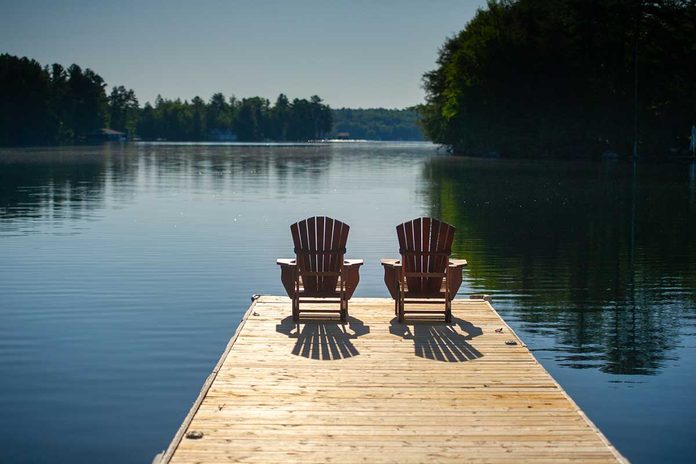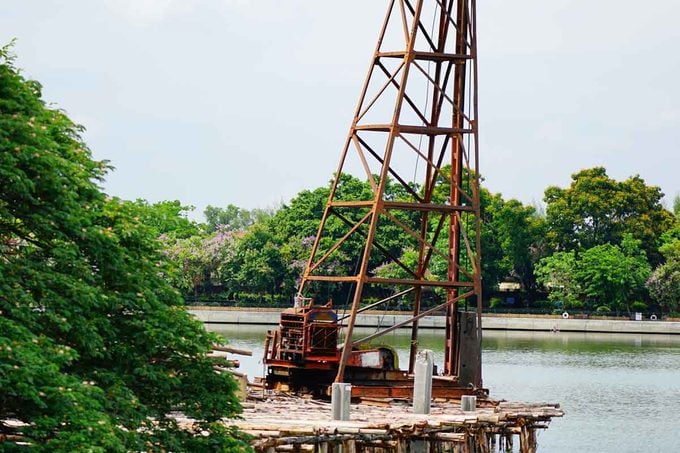8 Dock Installation Tips
Updated: Aug. 31, 2023

Have some waterside property that could use a dock? Follow these tips to help streamline floating, crib, pile, pipe and lift dock installations.
That initial dock installation job is, admittedly, a big one, but it’s a necessary part of getting your cabin ready for the season. You can hire a service to handle it, or you can save that money for a new water toy and take on the installation yourself.
Whether you’re installing a floating dock, crib dock, pile dock, pipe dock or lift dock, the tips below will help your dock installation project run much more smoothly, giving you more time to enjoy your waterside getaway. Then, learn how to prepare a boat dock for winter, too.
On This Page
Choose the Right Decking Material
If you’re building your dock from scratch rather than using a prefabricated kit, choosing the right material matters. This is true of all dock types and styles. The top surface of your dock will take a beating over the years. UV rays, wind, waves, sand and foot traffic will all slowly contribute to your dock’s wear and tear. That’s why it’s vital to choose the most wear- and rot-resistant material possible.
If you have your heart set on a wooden dock, cedar boards are your best bet. The natural oils in cedar make it extremely rot-resistant, and that’s key in a high moisture environment. If you can’t find cedar, choose pressure-treated pine or spruce, as long as your municipality allows treated lumber in lakes.
Or, skip wood entirely and go with composite decking. Made of a blend of wood fibers and plastic, composites won’t rot, don’t require finishing and are exceptionally wear-resistant.
Mark for Your Dock Fasteners
As a productivity-minded DIYer, efficiency in building projects probably matters to you, as it should. Trouble is, efficiency can sometimes be an excuse to cut corners, leading to sloppier, less professional results. This can happen with all types of construction projects, including dock installation.
One of the most common ways folks cut corners when building docks is not marking for fasteners. The idea of measuring along each board of your dock, then marking pencil lines to guide the location of nails or screws, might seem like overkill, but the visual difference it makes is enormous. No matter how good your eyes are, you’ll never drive all the nails and screws a consistent distance from the edges and ends of boards, with equal spacing between them, without measuring.
Invest a little time with a tape measure and pencil, and make your fasteners laser straight and equally spaced. Doing so will give your dock a much neater, more professional appearance that you’ll be proud of every time you tie up your boat.
Use Galvanized Dock Fasteners
Unless you opt for a floating unit made exclusively of foam or plastic, your dock building project will probably involve driving fasteners. These might be framing nails, deck screws, lag bolts or threaded rod, depending on your dock’s design and what you’re fastening.
Regardless of fastener type, choosing hot-dipped galvanized fasteners is a must. Regular, non-coated nails, screws and bolts might look beefy, but they’ll rust like crazy as soon as they get wet. Leave them for too long, and they’ll shed enough metal to become critically weak, putting your entire dock at risk. Hot-dipped galvanized fasteners will resist rust for years, even when they’re constantly exposed to the elements.
Rent the Right Equipment

Depending on the size, shape and design of your dock, you may need to hire heavy machinery like an excavator or piledriver to get it installed. These machines aren’t cheap to rent, but for big dock installation, they may well be your only option.
The wooden cribs that support crib docks, for example, are big and heavy, even before they’re filled with stones. You may be able to wrestle them into the water manually with the help of some strong friends, but larger cribs make this unlikely. An excavator can make crib installation much easier. Some strategically placed chains and a skillful operator will get your cribs in the water in no time.
For pile docks, a piledriver will most likely be needed to pound the pilings into the lakebed.
Anchor Your Floating Dock Properly
In a deep lake with a soft, muddy bottom, or a lake that fluctuates in depth more than a foot or so over the course of a year, a floating dock is often the best choice.
Keep the anchoring system in mind when installing your floating dock. Concrete block anchors are the easiest and most common option, and they’re easy to make yourself if your dock kit doesn’t include them.
Whether you go with ready-made anchors or pour your own, you’ll probably need at least four to make your dock secure enough to avoid spinning around in windy, wavy conditions. Aim for an individual anchor weight of at least 250 lbs. or so, even more if your dock is large. Fasten one concrete anchor to each corner of your dock with thick galvanized chains, crisscrossing the chains so each anchor is adjacent to the corner of the dock it’s fastened to. This makes for a stronger installation.
Be sure to fasten the anchor chains to the dock using heavy-duty, openable chain links. That way you can remove the dock as you close your cabin at the end of each season and easily replace it next season.
Don’t Skimp On Crib Dock Timbers
Crib docks are an extremely solid, permanent dock design requiring little or no maintenance once they’re in the water. Made by setting thick timber crates or “cribs” in the water, filling them with heavy stones, then building the dock structure on top, crib style docks are a mainstay for anglers and boaters interested in hitching their vessels to something secure and fairly permanent. Trouble is, it’s easy to build the all-important cribs the wrong way, leading to premature failure.
Avoid this by using thick, pressure-treated beams for the underwater portion of your crib dock. Go with timbers at least 6×6 inches. Don’t forget to cover the crib bottoms in lumber, so the rocks won’t slowly sink into the lake bottom. Before building, double check that your community doesn’t prohibit use of pressured treated lumber in local lakes.
Choose the Right Spot for Your Pipe Dock
Pipe docks are simple to install and maintain, but they need the perfect spot to work — shallow water with a fairly firm lake bottom.
Since pipe docks are mounted on aluminum legs or “pipes” that reach right to the bottom, you’ll have a lot of trouble installing one if the water’s much deeper than six to seven feet. And if you’re working with an extremely soft and silty lake bottom, there’s a good chance the legs will sink over time, taking the dock with it. One work-around for soft-bottom lakes: Add flat aluminum plates called pipe feet to the ends of your pipes for support.
Mount Your Lift Dock Solidly
If you’re planning to install a lift dock that tilts out of the water during the off–season, anchoring the hinge plate correctly is vital. You’ll need something flat, heavy and strong to bolt the hinge plate to ensure the dock swings up and docks correctly when hooked up to a winch.
If your section of shoreline happens to be made of flat, unbroken rock, you’re in luck. With a rock drill and some masonry anchor bolts, you can fasten your hinge plate directly to the rock. Otherwise, you’ll need to pour a large, thick concrete pad (exact size varies with dock size), or build a crib and fill it with stones. Both options provide a solid backing for your lift dock’s hinge plate.
